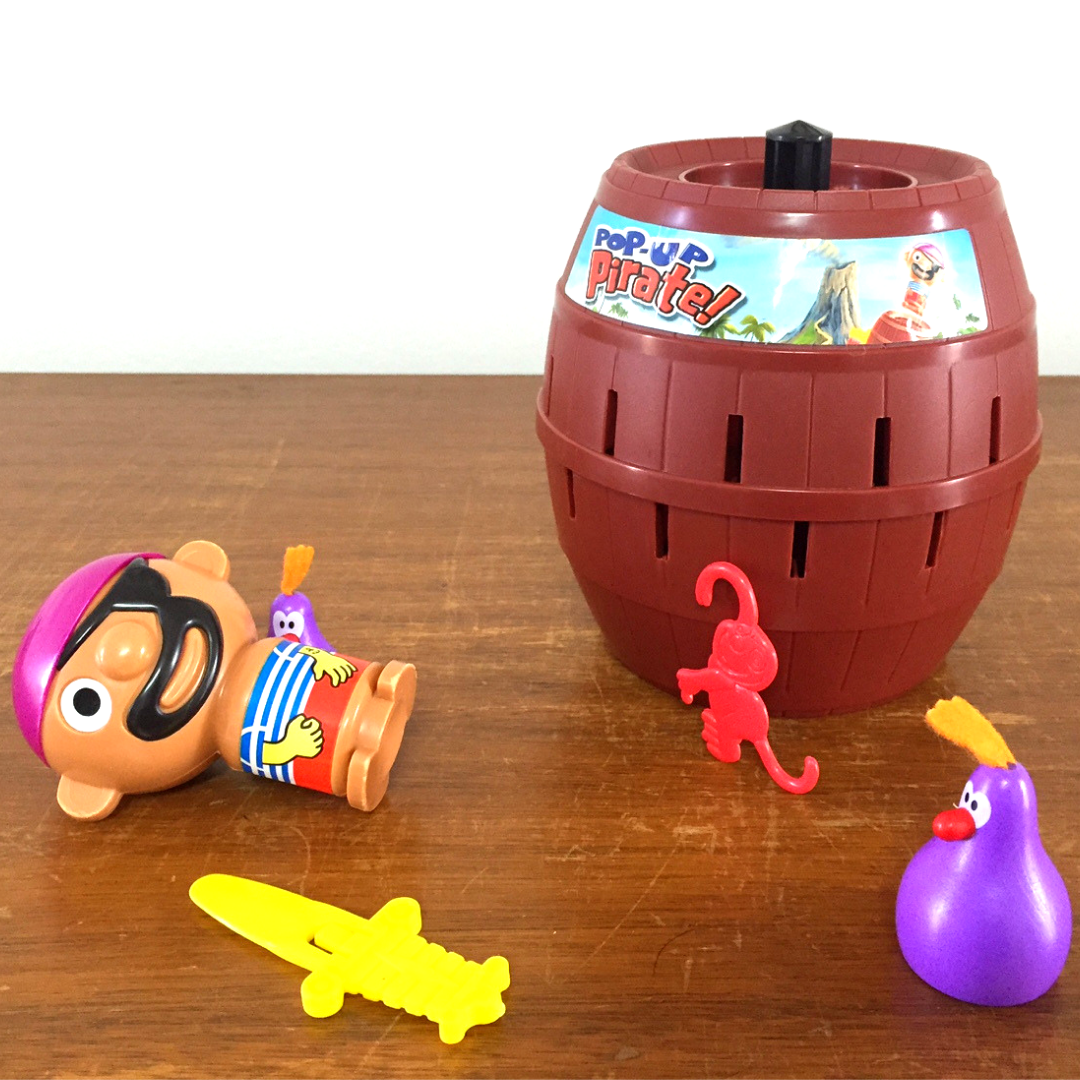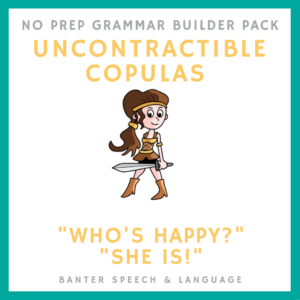Speech pathology for kids: Is it time to put away the Pop-Up Pirate and just do the therapy?
Most speech pathologists who work with preschoolers and young school-aged children have hundreds of toys and games* to use in speech-language therapy.
Why?
The superficial answer is to motivate children to do the work. But the real answer is much more interesting. It took a surprising amount of reading to find some answers. And we have to travel back in time to explain it in context.
Once upon a time, in the land of rewards and punishments…
In 1957, an American scientist called B.F Skinner published an influential book called “Verbal Behavior”. This work inspired lots of research applying so-called “behaviour principles” to the treatment of speech and language disorders, including stuttering, articulation disorders, and expressive and receptive language disorders.
Skinner and his followers thought that you could objectively observe, measure and then change a person’s behaviour by manipulating what happened (or didn’t happen) when the person did (or didn’t do) something. “Behaviourists” (as they came to be known) argued that one way to seek to change a person’s behaviour is to reward the behaviour you want, and to punish the behaviour you don’t want.
None of this will be a surprise to parents and teachers. Many parents – me included – use things like reward charts and pocket money to motivate children to complete tedious yet important tasks like washing up and making their beds (Joussemet et al., 2004). And gold stars, certificates, and privileges are used frequently to promote behaviour in schools (e.g. Newby 1991), especially for children with behavioural issues.
By the 1970s, many speech pathologists were applying behaviour principles in their speech and language therapy sessions. For perhaps most of us, this is still the case today. University courses to this day teach elementary goal-setting, session planning, data collection and outcome measurement using the language of behaviourism.
What does speech-language therapy based on behaviour principles looks like?
Before the therapy session, the speech pathologist creates a list of objective, measurable goals for the child to demonstrate. For example: “Mary will name high frequency, regular past tense verbs in subject-verb sentence forms, with 80% accuracy in the clinic with the speech pathologist”. The speech pathologist will prepare a list of target verbs to trial for that goal, e.g. hopped, jumped, kissed, etc. as well as materials (scripts, worksheets, flashcards, etc.) to help stimulate the target.
In the session, the speech pathologist:
- presents the child with some materials and words, e.g. pictures and instructions for each target verb. These are designed to stimulate the child to act in a certain way and/or to say something (e.g. to name the verb depicted on the flashcard in subject-verb sentences, e.g. “He hopped”);
- impartially observes and measures the child’s response (whatever it is); then
- responds to the child’s response with a consequence. The consequence depends on the goal and the child’s response. In other words, the consequence is contingent on the child’s response:
- If the child’s response is what the speech pathologist wants to achieve – e.g. a past tense verb in a subject-verb sentence – the consequence will be positive, to reinforce the response, and to make it more likely that the child will repeat the behaviour under similar conditions in the future. In other words, the child is rewarded if she produces the target behaviour correctly.
- If the child’s response is not what the speech pathologist wants, the consequence is negative: to make it less likely that the child would repeat the behaviour in similar conditions in the future. In other words, the child is punished if they miss the target.

In some of the behavioural speech pathology research published in the early and mid-1970s, the researchers talk about “reinforcers” and “punishers” (e.g. Brookshire, 1973). Although these terms inspire visions of bribery and electric shocks, they are much less dramatic in speech therapy:
- Reinforcers might include rewards like stamps, gold stars, certificates, tokens (like Pop-Up Pirate swords, shells, dinosaurs, and plastic-gold coins), play-time with desired toys like Lego or Ooshies, time for desired activities like screen time, (rarely) food, ticks, and verbal praise.
- Punishers might include things like the absence or removal of rewards or (mildly) negative comments on behaviour.
Why use reinforcers?
Even in this early research, speech pathologists knew that reinforcers and punishers (now usually called consequences or contingencies) served at least two different functions:
- Incentives: Rewards can motivate children to do things we want them to do. Some children may also be motivated to act in a way that avoids being punished.
- Feedback: Rewards and punishments can signal to the child how they are performing relative to a given target behaviour. Getting the reward signals that they are doing well.
Not so simple in practice
The problem with using rewards as an incentive to do the work is that the child might not do the work without the incentive, e.g. in other places and with other people. This is a big problem: there is no point doing speech therapy if the results don’t transfer to the real world.
In practice, the two functions – incentive and feedback – are often mixed up. For example, imagine the target is for the child to say regular past tense verbs correctly in subject-verb sentences. The speech pathologist shows the child a picture of a kangaroo mid-jump and says: “I took this picture last week. Can you tell me, what the kangaroo did?”
- If the the child says “The kangaroo jumped!”, the speech pathologist might reward the (wanted) behaviour with a stamp and/or verbal praise (hopefully something specific, and not the dreaded “Good talking!”).
- If the child says, “The kangaroo jump”, the speech pathologist might ‘punish’ the (unwanted) behaviour by withholding the stamp, and perhaps recasting the sentence, “The kangaroo jumped. What did he do? He jumped”.
In this case, is the child construing the rewards and punishments as an incentive to keep going, as feedback on her performance, or a mixture of both? More importantly, what if the child doesn’t care at all about the stamps and praise, but just wants to learn how to say past tense verbs properly to avoid feeling embarrassed when speaking with friends about what happened on the weekend? Or, worse, what if the child doesn’t respond at all to reinforcement, puts her head down on the table and goes on strike?
Behavioural therapy has its limits
In the late 1970s, and 1980s:
- many speech pathologists started to question whether behavioural training was always appropriate, especially for a biologically primary function like language. Some researchers found that many speech and language skills taught well with behavioural techniques in the clinic with the speech pathologist did not transfer across to the “real world” in natural, non-training contexts (e.g. Prizant, 1982, Lovaas et al., 1973); and
- several competing theories of language development emerged, including social learning theory (Bandura, 1977), interaction theory (Bloom & Lahey, 1978), and transformational grammar theory (Erreich et al., 1980). Some – particularly transformational grammar theory – made speech pathologists question the use of reinforcement in language therapy. Some speech pathologists started to focus more on a child’s natural social, language and physical environments, and to work in more natural, more facilitative, and less intrusive ways.
In the 1990s and 2000s, researchers showed (or at least argued) that:
- in some cases, rewards can undermine children’s natural interest in activities, and also interfere with the cultivation of their ability to value uninteresting but important activities (e.g. Ryan & Deci, 2000);
- for activities that a child finds inherently interesting, using rewards can lead to a decrease in intrinsic motivation, i.e. spontaneous engagement decreases when rewards are added (Deci et al., 1999);
- encouraging the use of fantasy and affording opportunities for choice can promote a child’s interest and task engagement (e.g. Cordova & Lepper, 1996);
- the goal of therapy should be to promote autonomous self-regulation – not just compliance with external controls – and that rewards may interfere with the internalisation of the activity’s value. They advocate “autonomy support” – encouraging initiative and providing meaningful rationales for requests, and minimising “controlling” language – a beneficial alternative to rewards (e.g. Joussemet et al., 2004);
- principles of motor learning – including delayed, infrequent feedback on results (not production) – should be employed when targeting motor speech disorders like apraxia of speech or hypokinetic dysarthria; and
- if mismanaged, external rewards can slow down therapy, distract from the child’s goals, and decrease the dose of therapy the child gets in each session.
The missing piece: What does the child think?
Research based on “cognitive evaluation theory” suggests that it is not the reward itself that determines whether it will magnify or diminish the client’s intrinsic motivation to do a task, but what the client thinks about the reward:
- If the child thinks getting the reward is the purpose for doing the work, the child may associate the work and the reward as something controlled by the speech pathologist to achieve the speech pathologist’s goal. If so, the child may stop doing the work when the speech pathologist isn’t there and the reward stops or is removed.
- If the child thinks that the reward is just an indicator – a sign – of her competence and success, her intrinsic motivation may not be undermined. The child may think that the reward just shows her that she can do the task (e.g. Hagger et al., 2014).
This research is similar in some ways to the 1970s studies on the incentive and feedback functions of rewards, except that it looks at rewards from the child’s perspective and makes predictions about what will happen when the reward is removed based on the child’s views.
Don’t throw the baby out with the bathwater!
Despite these developments, behavioural treatments remain popular, in part because they often help children achieve their goals! Examples include:
- Applied Behavioural Analysis (ABA) and Discrete Trial Training (DTT), common treatment approaches for children with autism spectrum disorders;
- the Lidcombe Program for preschoolers who stutter, a treatment that uses verbal (spoken) reinforcers and punishers (contingencies) to improve speech fluency; and
- many therapies for preschoolers and school-age children with speech sound disorders and/or developmental language disorders, including traditional articulation therapy and some drill-based therapies for expressive syntax.
In practice, many speech pathologists – me included – use “hybrid” approaches that combine behaviour principles with more naturalistic, interactive therapies that reward the spontaneous production of the target through the natural consequence of hitting the target (rather than an external reward). For example, I sometimes use elements of so-called milieu therapy to work on indirect requests. With this approach, the child gets the object they want if they ask for it using the target grammatical form, e.g. “Can I please have the Batcave?”
Clinical bottom line
We have a lot more to read on this important topic. But some important practical conclusions flow from the research we have reviewed to date, which will continue to affect how we use rewards in therapy:
- Behaviour principles still play a big role in speech pathology for preschoolers and school-aged kids, especially for objective goal setting, outcome measurement, and of course for evidence-based behavioural treatments like the Lidcombe Program for stuttering.
- Speech pathologists need additional tools so they can mix and match therapies and adapt their approach to each child’s goals and needs. We need to be less rigid, and more flexible – especially when behaviour principles aren’t working for a client.
- Even for younger kids, we should explain what we are working on and why it might matter to them in the real world before getting stuck into the work.
- When it comes to external rewards, speech pathologists should continue to think carefully about why and how they are using them in therapy.
- Ideally, we want children to view external rewards as indicators of their success in hitting their goals (rather than as the purpose of the activity).
- To increase self-motivation, we should give kids more choices in therapy (e.g. in the order of activities and the type of rewards offered for their hard work and success).
For children who are intrinsically motivated to work on their communication skills for the purpose of achieving their goals, we should put away the external reinforcers and just get on with it!
Related articles and resources:
- For struggling school kids, what’s the difference between seeing a speech pathologist and a tutor?
- How to use principles of motor learning to improve your speech
- Why does the Lidcombe Program for childhood stuttering work: a case of “words will never hurt me”?
- Resources to learn grammar: using auditory bombardment to improve kids’ expression and grammar skills
- “Can I go to the…?” and “Can I have…?” Questions Pack
- School-age stuttering research update: mixing and matching treatments to get results
Principal sources:
Brookshire, R.H. (1973). The Use of Consequences in Speech Pathology: Incentive and Feedback Functions, Journal of Communication Disorders, 6, 88-92.
Ogletree, B.T. & Oren, T. (2001). Application of ABA Principles to General Communication Instruction. Focus on Autism and Other Developmental Disabilities, 16(2), 102-109.
Joussemet, M., Koestner, R., Lekes, N., and Houlfort, N. (2004). Introducing Uninteresting Tasks to Children: A Comparison of the Effects of Rewards and Autonomy Support, Journal of Personality, 72:1, 140-166.
Hagger, M.S., Keatley, D.A., Chan, D.C.K, Chatzisarantis, N.L.D., Dimmock, J.A., Jackson, B., Ntoumis, N. (2014). The Goose is (Half) Cooked: a Consideration of the Mechanisms and Interpersonal Context is Needed to Elucidate the Effects of Personal Financial Incentives on Health Behaviour. International Journal of Behavioral Medicine, 21:197-201.
_____________________________________________
* Our shelves, for example, are packed with Pop-Up Pirates, dinosaurs, gold coins, stamps, magnets, stickers, Pokemon cards, Tumbling Chimps, Transformers, Star Wars, Lego, Ooshies, and board games. Like nesting birds, we’ve also collected loads of natural objects, including polished rocks, shells, carnivorous plants and even (plastic-encased) bugs. We use these things regularly in speech therapy sessions with preschoolers and school-aged children.

Hi there, I’m David Kinnane.
Principal Speech Pathologist, Banter Speech & Language
Our talented team of certified practising speech pathologists provide unhurried, personalised and evidence-based speech pathology care to children and adults in the Inner West of Sydney and beyond, both in our clinic and via telehealth.









 (L264) The No Prep Grammar Builder: Uncontractible Copulas (“Who’s happy?” “She is!”)
(L264) The No Prep Grammar Builder: Uncontractible Copulas (“Who’s happy?” “She is!”)